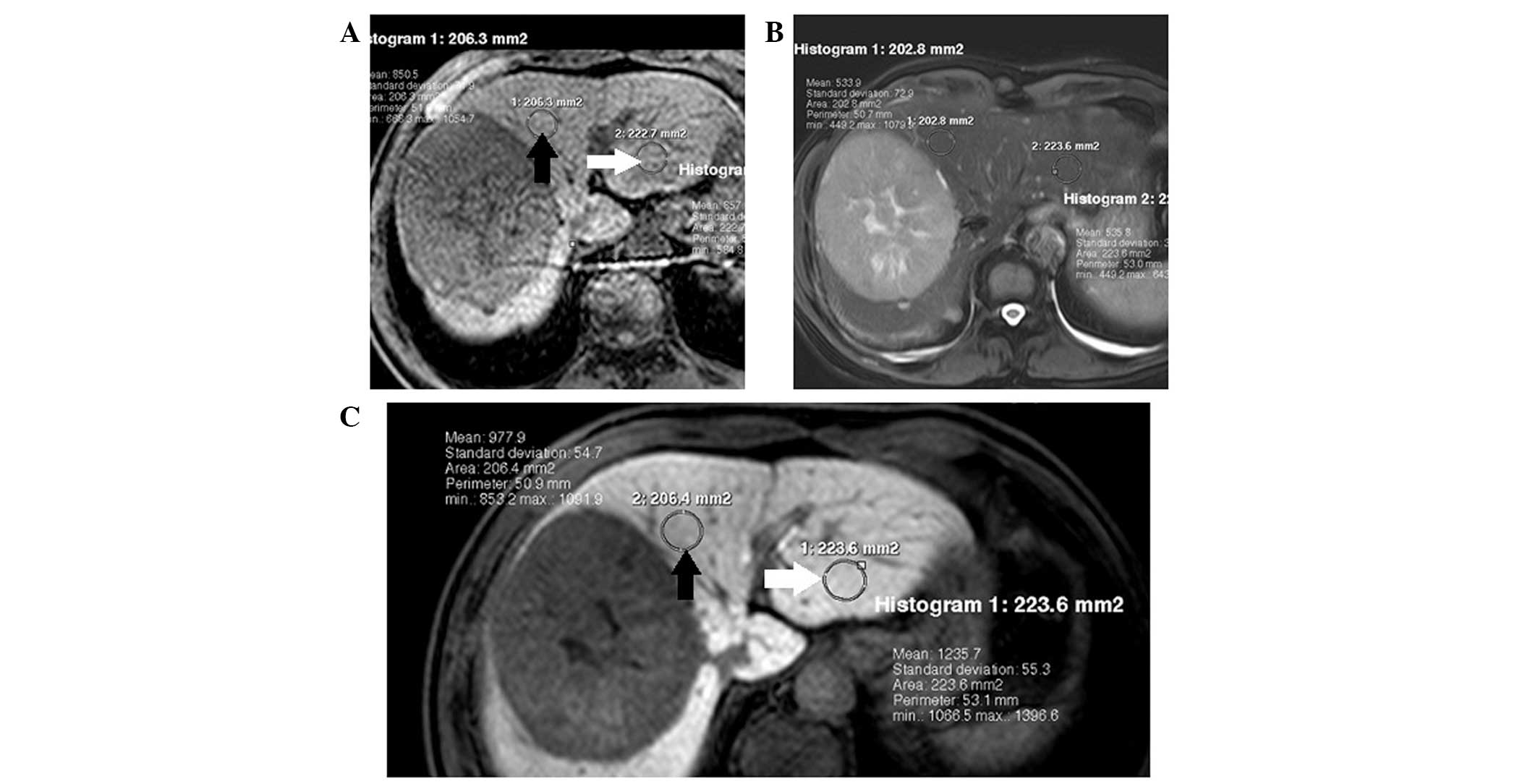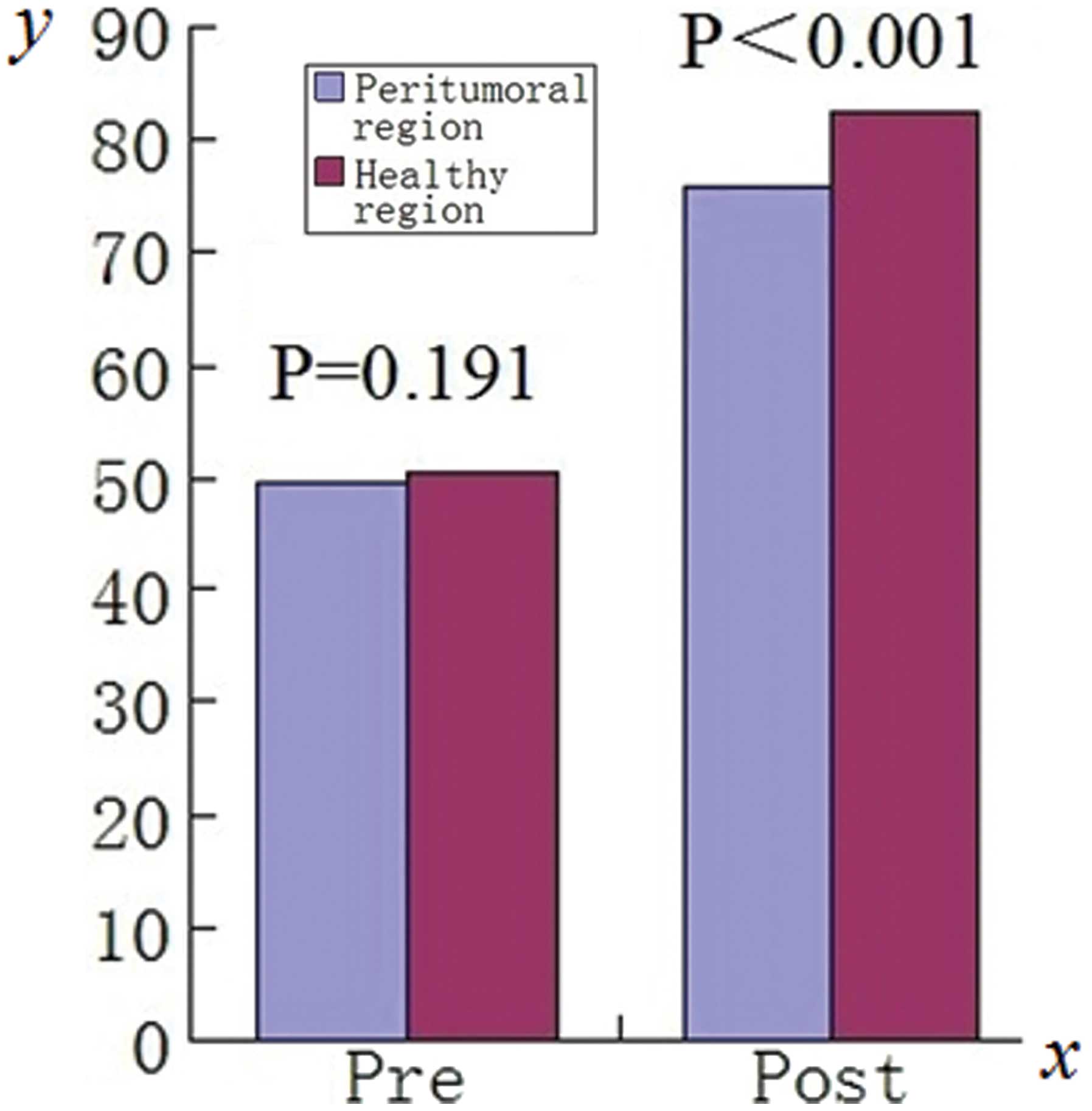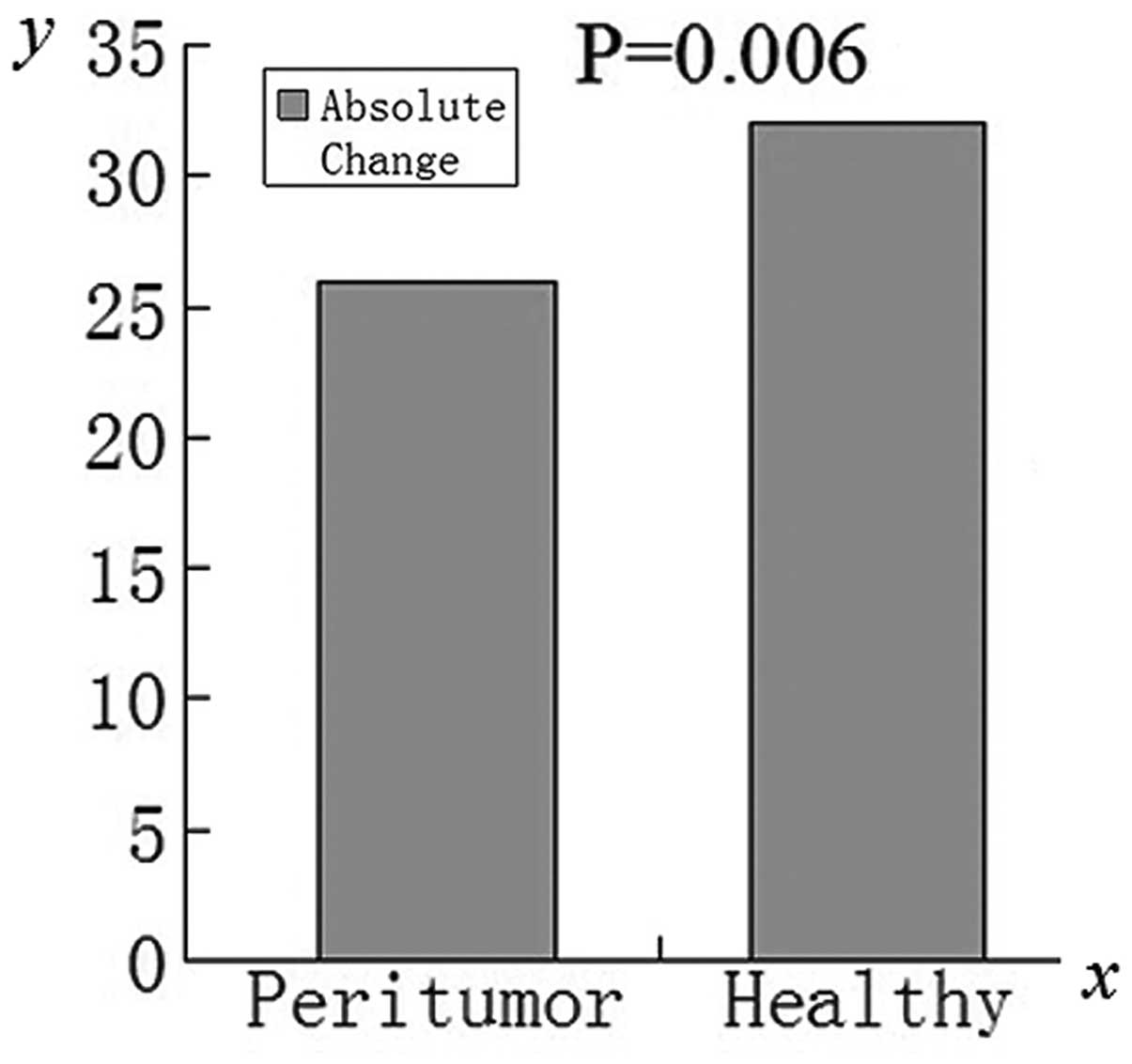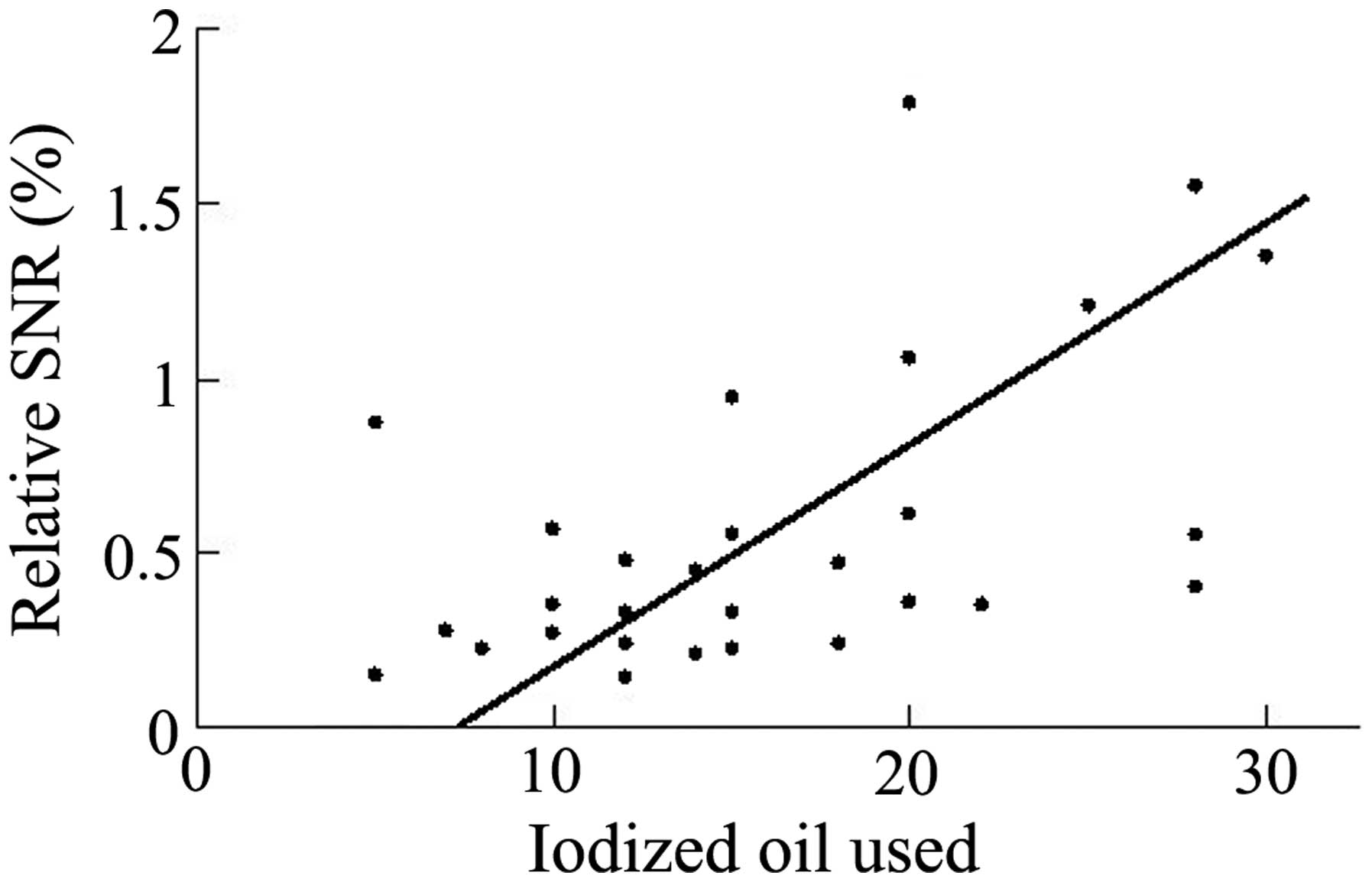|
1
|
Liu M, Liu J, Wang L, et al: Association
of serum microRNA expression in hepatocellular carcinomas treated
with transarterial chemoembolization and patient survival. Plos
One. 9:e1093472014. View Article : Google Scholar : PubMed/NCBI
|
|
2
|
Parikh JG, Kulkarni A and Johns C:
α-smooth muscle actin-positive fibroblasts correlate with poor
survival in hepatocellular carcinoma. Oncol Lett. 7:573–575.
2014.PubMed/NCBI
|
|
3
|
Guiu B, Minello A, Cottet V, et al: A
30-Year, Population-Based Study Shows Improved Management and
Prognosis of Hepatocellular Carcinoma. Clin Gastroenterol Hepatol.
8:986–991. 2010. View Article : Google Scholar : PubMed/NCBI
|
|
4
|
Odisio BC, Galastri F, Avritscher R, et
al: Hepatocellular carcinomas within the Milan Criteria: predictors
of histologic necrosis after drug-eluting beads transarterial
chemoembolization. Cardiovasc Intervent Radiol. 37:1018–1026. 2014.
View Article : Google Scholar
|
|
5
|
Le PH, Huang SC, Lim SN, et al: Complex IV
subunit 1 defect predicts postoperative survival in hepatocellular
carcinoma. Oncol Lett. 7:1430–1438. 2014.PubMed/NCBI
|
|
6
|
Choi WJ, Jeong WK, Kim Y, et al:
Assessment of treatment success and short-term effectiveness using
C-arm CT immediately after hepatic chemoembolization of HCC.
Hepatogastroenterology. 61:1353–1358. 2014.PubMed/NCBI
|
|
7
|
Livraghi T, Mäkisalo H and Line PD:
Treatment options in hepatocellular carcinoma today. Scand J Surg.
100:22–29. 2011.PubMed/NCBI
|
|
8
|
Llovet JL, Real MI, Montaña X, et al:
Arterial embolisation or chemoembolisation versus symptomatic
treatment in patients with unresectable hepatocellular carcinoma: a
randomised controlled trial. Lancet. 359:1734–1739. 2002.
View Article : Google Scholar : PubMed/NCBI
|
|
9
|
Schuette K, Bornschein J, Milbradt O,
Mohnike K, Stuebs P and Malfertheiner P: Transarterial
chemoembolization (TACE) does have little impact on hepatic
metabolic function in patients with hepatocelluar carcinoma (HCC).
J Clin Oncol. 29:e145272011.
|
|
10
|
Di Martino M, Marin D, Guerrisi A, et al:
Intraindividual comparison of gadoxetate disodium-enhanced MR
imaging and 64-section multidetector CT in the detection of
hepatocellular carcinoma in patients with cirrhosis. Radiol.
256:806–816. 2010. View Article : Google Scholar
|
|
11
|
Nilsson H, Blomqvist L, Douglas L, Nordell
A, et al: Gd-EOB-DTPA-enhanced MRI for the assessment of liver
function and volume in liver cirrhosis. Brit J Radiol.
86:201206532013. View Article : Google Scholar : PubMed/NCBI
|
|
12
|
Katsube T, Okada M, Kumano S, et al:
Estimation of liver function using T1 mapping on
Gd-EOB-DTPA-enhanced magnetic resonance imaging. Invest Radiol.
46:277–283. 2011. View Article : Google Scholar : PubMed/NCBI
|
|
13
|
Bae KE, Kim SY, Lee SS, et al: Assessment
of hepatic function with Gd-EOB-DTPA-enhanced hepatic MRI. Dig Dis.
30:617–622. 2012. View Article : Google Scholar : PubMed/NCBI
|
|
14
|
Pancholy SB, Sanghvi KA and Patel TM:
Radial artery access technique evaluation trial: randomized
comparison of seldinger versus modified seldinger technique for
arterial access for transradial catheterization. Catheter
Cardiovasc Interv. 80:288–291. 2012. View Article : Google Scholar : PubMed/NCBI
|
|
15
|
Huang YS, Chiang JH, Wu JC, Chang FY and
Lee SD: Risk of hepatic failure after transcatheter arterial
chemoembolization for hepatocellular carcinoma: predictive value of
the monoethylglycinexylidide test. Am J Gastroenterol.
97:1223–1227. 2002. View Article : Google Scholar : PubMed/NCBI
|
|
16
|
Chen X, Zhang HB, Li ZQ, et al:
Indocyanine green clearance in evaluating the recovery of liver
reserve function after superselective transarterial
chemoembolization. Hepatob Pancreat Dis. 12:656–660. 2013.
View Article : Google Scholar
|
|
17
|
Min YW, Lee JH, Gwak GY, et al: Long-term
survival after surgical resection for huge hepatocellular
carcinoma: comparison with transarterial chemoembolization after
propensity score matching. J Gastroen Hepatol. 29:1043–1048. 2014.
View Article : Google Scholar
|
|
18
|
Shimizu J, Dono K, Gotoh M, et al:
Evaluation of regional liver function by
gadolinium-EOB-DTPA-enhanced MR imaging. Dig Dis Sci. 44:1330–1337.
1999. View Article : Google Scholar : PubMed/NCBI
|
|
19
|
Yamada A, Hara T, Li F, et al:
Quantitative evaluation of liver function with use of gadoxetate
disodium-enhanced MR imaging. Radiology. 260:727–733. 2011.
View Article : Google Scholar : PubMed/NCBI
|
|
20
|
Leonhardt M, Keiser M, Oswald S, et al:
Hepatic uptake of the magnetic resonance imaging contrast agent
Gd-EOB-DTPA: role of human organic anion transporters. Drug Metab
Dispos. 38:1024–1028. 2010. View Article : Google Scholar : PubMed/NCBI
|
|
21
|
Zhang W, He YJ, Gan Z, et al: OATP1B1
polymorphism is a major determinant of serum bilirubin level but
not associated with rifampicin-mediated bilirubin elevation. Clin
Exp Pharmacol Physiol. 34:1240–1244. 2007. View Article : Google Scholar : PubMed/NCBI
|
|
22
|
Lao XM, Wang D, Shi M, et al: Changes in
hepatitis B virus DNA levels and liver function after transcatheter
arterial chemoembolization of hepatocellular carcinoma. Hepatol
Res. 41:553–563. 2011. View Article : Google Scholar : PubMed/NCBI
|
|
23
|
Saito M, Seo Y, Yano Y, et al: Short-term
reductions in non-protein respiratory quotient and prealbumin can
be associated with the long-term deterioration of liver function
after transcatheter arterial chemoembolization in patients with
hepatocellular carcinoma. J Gastroenterol. 47:704–714. 2012.
View Article : Google Scholar : PubMed/NCBI
|
|
24
|
Schuhmann-Giampieri G, Schmitt-Willich H,
Press WR, et al: Preclinial evaluation of Gd-EOB-DTPA as a contrast
agent in MR imaging of the hepatobiliary system. Radiology.
183:59–64. 1992. View Article : Google Scholar : PubMed/NCBI
|
|
25
|
Planchamp C, Montet X, Frossard JL, et al:
Magnetic resonance imaging with hepatospecific contrast agents in
cirrhotic rat livers. Invest Radiol. 40:187–194. 2005. View Article : Google Scholar : PubMed/NCBI
|
|
26
|
Kim HY, Choi JY, Park CH, et al: Clinical
factors predictive of insufficient liver enhancement on the
hepatocyte-phase of Gd-EOB-DTPA-enhanced magnetic resonance imaging
in patients with liver cirrhosis. J Gastroenterol. 48:1180–1187.
2013. View Article : Google Scholar : PubMed/NCBI
|
|
27
|
Kanki A, Tamada T, Higaki A, et al:
Hepatic parenchymal enhancement at Gd-EOB-DTPA-enhanced MR imaging:
correlation with morphological grading of severity in cirrhosis and
chronic hepatitis. Magn Reson Imaging. 30:356–360. 2012. View Article : Google Scholar : PubMed/NCBI
|
|
28
|
Motosugi U, Ichikawa T, Sou H, et al:
Liver parenchymal enhancement of hepatocyte-phase images in
Gd-EOB-DTPA-enhanced MR imaging: which biological markers of the
liver function affect the enhancement? J Magn Reson Imaging.
30:1042–1046. 2009. View Article : Google Scholar : PubMed/NCBI
|
|
29
|
Utsunomiya T, Shimada M, Hanaoka J, et al:
Possible utility of MRI using Gd-EOB-DTPA for estimating liver
functional reserve. J Gastroenterol. 47:470–476. 2012. View Article : Google Scholar
|
|
30
|
Goshima S, Kanematsu M, Watanabe H, et al:
Gd-EOB-DTPA-enhanced MR imaging: prediction of hepatic fibrosis
stages using liver contrast enhancement index and liver-to-spleen
volumetric ratio. J Magn Reson Imaging. 36:1148–1153. 2012.
View Article : Google Scholar : PubMed/NCBI
|
|
31
|
Takao H, Akai H, Tajima T, et al: MR
imaging of the biliary tract with Gd-EOB-DTPA: effect of liver
function on signal intensity. Eur J Radiol. 77:325–329. 2011.
View Article : Google Scholar
|
|
32
|
Bickelhaupt S, Studer P, Kim-Fuchs C, et
al: Gadoxetate uptake as a possible marker of hepatocyte damage
after liver resection-preliminary data. Clin Radiol. 68:1121–1127.
2013. View Article : Google Scholar : PubMed/NCBI
|
|
33
|
Goel A, Mehta N, Guy J, et al: Hepatic
artery and biliary complications in liver transplant recipients
undergoing pretransplant transarterial chemoembolization. Liver
Transpl. 20:1221–1228. 2014. View
Article : Google Scholar : PubMed/NCBI
|
|
34
|
Negi SS and Chaudhary A: Analysis of
abnormal recovery pattern of liver function tests after surgical
repair of bile duct strictures. J Gastroenterol Hepatol.
20:1533–1537. 2005. View Article : Google Scholar : PubMed/NCBI
|













